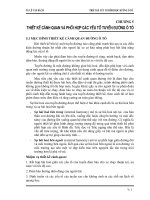- Trang chủ >>
- Đề thi >>
- Đề thi lớp 9
Thiết kế cống và cầu nhỏ trên đường ôtô [Thiết kế cống và cầu nhỏ trên đường ô tô]
Bạn đang xem bản rút gọn của tài liệu. Xem và tải ngay bản đầy đủ của tài liệu tại đây (216.37 KB, 7 trang )
<span class='text_page_counter'>(1)</span><div class='page_container' data-page=1>
Formal Methods
in
Software Engineering
</div>
<span class='text_page_counter'>(2)</span><div class='page_container' data-page=2>
Adding Formal Methods to a Project
• Remember using formal methods is not an all or
nothing process
• The level of rigor used should be tailored to fit the
specific project with respect to
– system criticality level
– budget
– schedule
</div>
<span class='text_page_counter'>(3)</span><div class='page_container' data-page=3>
Best Use of Formal Methods
• New system components
– adaptive or corrective maintenance
• Poorly understood requirements
– perfective maintenance
• Highly critical system components
</div>
<span class='text_page_counter'>(4)</span><div class='page_container' data-page=4>
Management Considerations part 1
• Project staff expertise
– Formal Methods Expert (seeks to match applications
with appropriate methods, tools, and techniques)
– Project Domain Expert (evaluates candidate application
and identifies the best to experiment with)
• Project scale
– best to only try applying formal methods on 1 or 2
components the first time out
</div>
<span class='text_page_counter'>(5)</span><div class='page_container' data-page=5>
Management Considerations part 2
• Project training
– use existing staff with formal methods expertise
– provide inhouse, handson training with formal
methods languages and support tools
– outside experts provide training and advice in early
project stages
• Process integration strategy
– few changes needed if requirements analysis procedure
are welldefined
</div>
<span class='text_page_counter'>(6)</span><div class='page_container' data-page=6>
Management Considerations part 3
• Project guidelines and standards
– writing formal specifications requires guidelines
similar to those found in existing
• configuration management procedures
• coding style guidelines
• documentation standards
</div>
<span class='text_page_counter'>(7)</span><div class='page_container' data-page=7>
Technical Considerations part 1
• Type of application
– applications with greater complexity will benefit more
from formal methods use than simple applications
– logic and discrete math applications benefit more than
numerical applications
• Size of application
– optimal code size is between 4K LOC and 25 KLOC
• Type of formal methods used
</div>
<!--links-->









